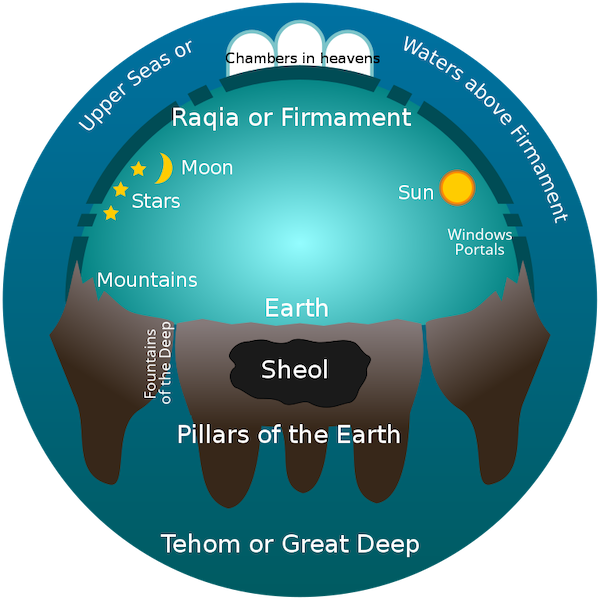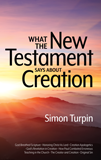
Enuma Elish: Did It Influence Genesis 1?
Does Genesis share a Mesopotamian worldview?
To justify a figurative (or partly figurative) reading of Genesis 1, theistic evolutionists utilize other creation accounts from the ancient Near East (ANE).1 One such account is the Mesopotamian “creation myth”2 Enuma Elish. The points of similarity supposedly show a shared conceptual worldview between Genesis 1 and Enuma Elish.3 This allows theistic evolutionists to argue that Genesis 1 is merely theological truth rather than historical fact. What is the relationship between Genesis 1 and Enuma Elish?
Enuma Elish
In 1849, Austen Henry Layard discovered an ancient Mesopotamian creation myth at Ashurbanipal’s library at Nineveh (modern-day Iraq). The myth was named Enuma Elish (“when on high”), and the seven tablets containing the creation myth, written in cuneiform, were translated in 1876. This translation originally led critical scholars to conclude that the creation account in Genesis 1 was dependent upon Enuma Elish (see Genesis 1:2 below).4 Similar to other pagan ANE myths, Enuma Elish has the preexistence of matter at the time of the first creative act:
When on high the heaven had not been named,
Firm ground below had not been called by name,
Naught but primordial Apsu, their begetter
(And) Mummu-Tiamat, she who bore them all,
Their waters commingling as a single body;
No reed hut had been matted, no marsh land had appeared,
When no gods whatever had been brought into being,
Uncalled by name, their destinies undetermined—
Then it was that the gods were formed within them (Tablet I:1–9).5
The beginning of Enuma Elish shows the world as a place where the chaotic waters (the god Apsu and the goddess Tiamat) are preexistent and born out of eternal matter.
The beginning of Enuma Elish shows the world as a place where the chaotic waters (the god Apsu and the goddess Tiamat) are preexistent and born out of eternal matter. Apsu, the male god of fresh water, procreates with Tiamat, the female goddess of salt water, which results in the creation of other gods who represent various aspects of nature. It was from the god Ea and the goddess Damkina that the god Marduk was born and later rose to supreme power. After defeating the goddess Tiamat in battle, Marduk uses her corpse (which he cuts in two) to create the sky and earth. Marduk then creates the sun, moon, and stars and gives them the role of marking the seasons. Enuma Elish is about how Marduk became the chief god in the Babylonian pantheon and is not so much a cosmogony (origin of the universe) as it is a theogony (the origin of the gods).6
There are several problems in believing that the supposed points of similarity between Enuma Elish and Genesis 1 show a shared conceptual worldview.
“In the Beginning” vs. “When God Began”
The beginning of Enuma Elish, which is said to resemble Genesis 1:1–2, begins with a temporal clause (see above, “When on high . . .”). Since Enuma Elish begins with a temporal clause, some theistic evolutionists argue that Genesis 1:1 should be translated as a temporal clause (an incomplete sentence), reading, “When God began to create heaven and earth…”7 (cf. NRSV). This translation suggests that when God began creating, he started with preexistent matter and leaves open the possibility that the heavens and earth had already been in existence for long ages (i.e., billions of years). God is presented as transforming the earth from a chaotic state into an ordered state (cf. Genesis 1:2–31). This is contrary to the traditional translation of Genesis 1:1 as an absolute clause, “In the beginning, God created the heavens and the earth” (ESV; KJV; NKJV; NASB).8
In Genesis 1:1, the Hebrew word bərē'šît (“in the beginning”) has the preposition bǝ (בְּ), “in,” followed by the noun rēʾšît (רֵאשִׁית), “beginning.” The word bǝrēʾšît does not have a definite article (it is anarthrous), and so its form could either be the absolute or construct state.9 There are several reasons, however, to believe that bǝrēʾšît is in the absolute state (cf. Isaiah 46:10), stressing the absolute beginning of all things.
First, ancient versions of Genesis 1:1 interpreted bǝrēʾšît as referring to the absolute beginning of all things.10 For example, the Septuagint (LXX) translates bǝrēʾšît as an absolute clause, “In the beginning . . .” (ἐν ἀρχῇ, cf. John 1:1).11 Second, “when rēʾšît occurs in the construct state, it either has a pronominal suffix (e.g., Numbers 18:12; Job 8:7), a vowel contraction (e.g., Deuteronomy 11:12), or is part of a chain of constructs terminated by a definite absolute noun (e.g., Jeremiah 26:1, 27:1), yet none of these indicators are present in Genesis 1:1.”12 Third, nothing in Genesis 1 mentions the rearranging of preexistent matter; rather, Genesis 1:1 implies the creation of matter (heaven and earth). This is supported by the Old and New Testament teaching that until God spoke, nothing existed (Psalm 33:6, 9; Proverbs 8:22–26; John 1:1–3; Hebrews 11:3). The opening temporal clause of Enuma Elish does not parallel Genesis 1:1.13
“The Deep” vs. Tiamat
In Enuma Elish, creation is the result of a chaotic battle between the gods, where Marduk defeated Tiamat and used her decapitated body to create the sky and keep the water from escaping (see below). It was originally argued by critical scholars that the reference to “the deep” (Genesis 1:2) was a remnant of the battle between Marduk and Tiamat which was demythologized by the Hebrews. One of the reasons for this was that the Babylonian goddess “Tiamat” is said to sound like the Hebrew word for “deep,” tǝhôm. For critical scholars, this meant that in Genesis 1:2, the Hebrew God also had to conquer the goddess of chaos, Tiamat, in the form of the “deep.” Some theistic evolutionists still argue that tǝhôm is linguistically related to Tiamat, which therefore indicates the world was in a chaotic state to begin with.14
Many scholars now recognize that although tǝhôm and Tiamat are related to a common Semitic root, tǝhôm is not derivative of Tiamat.15 The Hebrew word tǝhôm (“deep”) is a masculine common noun, whereas Tiamat is a feminine proper noun. Moreover, in Enuma Elish, “Tiamat” is a goddess, and in Genesis 1:2, the “deep” is not divine or alive but is simply a creation of God (cf. Isaiah 45:7). It is just physical water and not a chaos symbol. There is a clear difference between Tiamat and “the deep.” In Genesis 1:2, “the deep” is part of God’s creation which he will form into the inhabited world. Genesis 1:2–31 is not about God transforming the world from a chaotic state into an ordered state but about God transforming an uninhabitable earth into a place fit for man (cf. Isaiah 45:18). Because of man’s sin, God will later use the “deep” to destroy the world (Genesis 7:11, 8:2).
Expanse vs. Three-Tiered Universe
In Enuma Elish, in the context of the firmament, Marduk cuts open the body of the defeated Tiamat and divides her waters in half to create the sky and to keep the water from escaping (Tablet IV 137–140). Theistic evolutionists believe that Genesis 1:6–8 “depicts the sky not as a slain goddess but as a solid dome (‘firmament’) to keep the waters above where they belong.”16 The mention of the “expanse” (firmament)17 in Genesis 1:6–8 is used to argue that the ancient Israelites believed in a three-tiered universe.18 In this ANE view of the world, the sky is seen as a hard dome resting on foundations, and the world is viewed as a disk floating on the waters that are held up by pillars (see image below).
Genesis 1 does not depict the “expanse” (rāqîaʿ) as a solid dome over the earth, nor does the Bible mention a three-tiered universe (Genesis 1:1; Deuteronomy 32:1; cf. Colossians 1:16). Although there are different views on the “expanse” amongst biblical creationists, it is probably best to see it as space (or sky).19 On day two of creation week, God calls forth the expanse to divide the waters above from the waters below (Genesis 1:6). On day four, God will place the sun, moon, and stars in the expanse (Genesis 1:17). Therefore, the expanse is most likely space, and the waters above are possibly still at the boundary of space (Psalm 148:4).20 The expanse, which the birds fly across, is probably the sky or atmosphere (Genesis 1:20). The waters below the expanse are the seas (Genesis 1:10) where the swimming creatures live (Genesis 1:22).
In Enuma Elish, the firmament comes about through violence, whereas God speaks the expanse into existence in Genesis 1:6–8. Moreover, when the Bible speaks of “windows of heaven” and “pillars of the earth,” it is using metaphorical language (cf. Genesis 7:11, 8:2; Job 9:6, 26:11; Psalm 75:3). The “windows of heaven” are mentioned twice in the flood account (Genesis 7:11, 8:2) and are metaphors of God’s provision of rain from clouds (cf. Genesis 9:13, 14, 16). The writers of the Bible knew rain came from clouds (Psalm 77:17; cf. Luke 12:54). The language “pillars of earth/heaven” found in poetic passages of the Bible also uses metaphors to describe things (i.e., the stability of the earth). The ancient Israelites were not ignorant people but had a knowledgeable (or revealed) understanding of the world (Job 26:7–10).
Greater and Lesser Lights vs. the Gods in the Heavens
In Enuma Elish, after slaying Tiamat, Marduk gives the sun, moon, and stars their role of marking the seasons, years, months, and weeks (Tablet V:2–4). It was the sun god, Šamaš, who is responsible for the year and the moon god, Nannar, who was appointed as the jewel of the night to fix the days. In ANE creation myths, the sun, moon, and stars were worshipped as gods.
In Genesis 1, God names the gathering of the waters, seas, and the dry land earth (Genesis 1:10), but he does not name the sun (šemeš) or moon (yārēaḥ); they are known together as the “two great lights” and individually as “the greater light” and the “lesser light” (Genesis 1:16). The fact that Moses does not name the sun or moon indicates that they are not gods. God is communicating to the Israelites (the original audience) that they may have heard that the sun, moon, and stars are gods (of Egypt) parading in the heavens, but they are not to worship or fear them. It is a warning to the people of Israel not to think that the heavenly bodies are gods. Why? God is not only warning against idolatry, but he is rejecting and refuting myth with history. The people of Israel knew the sun, moon, and stars were created things and were not to be worshipped (Deuteronomy 4:19). Furthermore, God placed the sun and moon in the heavens to aid man, “to give light on the earth” (Genesis 1:17), which rules out the idea that they are to be worshipped.
Biblical Worldview vs. ANE Worldview
Theistic evolutionists argue that because Genesis was written in an ANE context, the conceptual worldview of the ANE is reflected in Genesis 1.21 This means Genesis 1 is just another ANE cosmogonic myth and is meant to explain how the world was ordered and not how it originated (cf. Genesis 1:1, 7, 16, 21, 26, 27).22
The problem with this view is that it downplays the role of God in the inspiration of Scripture (2 Peter 1:20–21). As an inspired text, Genesis 1 not only gives us a true historical, chronological account of creation, but at the same time, it refutes all other ANE pagan myths regarding the creation of the world (i.e., Egyptian, Canaanite, Mesopotamian). This makes sense since Moses, whom the Holy Spirit moved to write the Torah, “was instructed in all the wisdom of the Egyptians” (Acts 7:22). Moses would be familiar with ANE literature and therefore able to refute myth with history.23
Genesis 1 is part of God-breathed Scripture (2 Timothy 3:16) and not simply the reflection of a shared conceptual worldview among the ANE. Genesis 1 is unique because it was given by the one true eternal, sovereign God and bears witness to his work in creation. The uniqueness of Genesis 1 sets it apart from Enuma Elish. Those who believe Genesis 1 shares a conceptual worldview with other ANE texts do so because of an a priori assumption that Genesis 1 is not unique among ANE myths, that is, it is not a God-breathed account of what took place at the beginning of history.
A significant problem for believing Enuma Elish is the background or conceptual worldview for Genesis 1 is that there is no consensus on the date of its composition. It has been dated to around 1800 BC24 and 1100 BC.25 If Enuma Elish was composed around 1100 BC, then it comes 300 years after Moses wrote the Torah (c. 1400 BC) and therefore cannot be the background to Genesis 1.26 Enuma Elish is most likely a distorted version (or cultural memory) of the original event of creation that was passed down among the unbelieving nations after the tower of Babel and corrupted and distorted over time (cf. Romans 1:21–23). Since the events of creation, the flood, and the dispersion at Babel occurred in history, we should not be surprised to find some reference to these in and throughout the ANE.
Genesis 1 is about the one true sovereign God who brings creation into existence; it is not about the origin of the gods. In Genesis 1, creation is not the result of a cosmic battle but the result of God’s powerful word (Genesis 1:3; Psalm 33:6), whereby he spoke things into existence in the space of six days (Exodus 20:11).27
Footnotes
- Peter Enns, The Evolution of Adam: What the Bible Does and Doesn’t Say about Human Origins (Grand Rapids, MI: Brazos Press, 2012), 38–43; Tremper Longman III, “What Genesis 1–2 Teaches (and What It Doesn’t)” in Reading Genesis 1–2: An Evangelical Conversation, ed. J. Daryl Charles (Peabody, MA: Hendrickson Publishers, 2013), 106–107.
- Enuma Elish is more a biography of Marduk and how he rose to be the chief god in the Babylonian pantheon.
- Enns acknowledges that Enuma Elish and Genesis 1 have significant differences and even admits that borrowing has not taken place. Enns, The Evolution of Adam, 39–41.
- Alexander Heidel concluded that there is no irrefutable evidence that Genesis 1 was based upon Enuma Elish. Alexander Heidel, The Babylonian Genesis: The Story of Creation, 2nd ed. (Chicago: University of Chicago Press, 1951), 82–140.
- E. A. Speiser, “Akkadian Myths and Epics,” in Ancient Near Eastern Texts Relating to the Old Testament Third Edition with Supplement, ed. James B. Pritchard (Princeton: Princeton University Press, 1974), 60–61.
- Gordon J. Wenham, Rethinking Genesis 1–11 (Eugene, OR: Cascade Books, 2015), 6–10.
- Enns, The Evolution of Adam, n.3. 154.
- For a defense of the traditional translation of Genesis 1:1, see Dr. Joshua D. Wilson, “Have We Misunderstood Genesis 1:1?” https://answersingenesis.org/hermeneutics/have-we-misunderstood-genesis-11/
- Kulikovsky notes, “Although bǝrēʾšît in Genesis 1:1 does not have the article, it would be a fallacy to claim that it is in the construct state because construct nouns never occur with the article. Indeed, only one of the fifty occurrences of rēʾšît in the absolute state (excluding Genesis 1:1) has the article (Nehemiah 12:44).” Andrew S. Kulikovsky, Creation, Fall, Restoration: A Biblical Theology of Creation (Scotland: Christian Focus Publications, 2009), 112.
- The suggestion that Genesis 1:1 is a temporal clause was also made by the medieval Jewish commentator Rashi (AD 1040–1105). However, Anderson points out: “The earliest translators of the Bible saw the issue much differently from Rashi or modern biblical scholars. In the Targums, Septuagint, and Vulgate, as well as in the midrashim and a number of apocryphal and pseudepigraphic works the possibility of taking the clause as temporal is avoided.” Gary Anderson, “The Interpretation of Genesis 1:1 in the Targums,” Catholic Biblical Quarterly 52, no. 1 (1990), 22.
- The apocryphal work 2 Maccabees (c. 150 BC) shows that early Jewish people had a concept of creation ex nihilo: “I beseech you, my child, to look at the heaven and the earth and see everything that is in them, and recognize that God did not make them out of things that existed. Thus also mankind comes into being” (2 Maccabees 7:28). Another apocryphal work 2 Esdras (c. 100 AD) not only takes Genesis 1 as referring to the beginning in an absolute way but speaks of heaven and earth as a product of God’s speech, the first thing that he made: “I said, ‘O Lord, you spoke at the beginning of creation and said on the first day, “Let heaven and earth be made,” and your word accomplished the work’” (2 Esdras 6:38).
- Kulikovsky, Creation, Fall, Restoration, 112.
- See Kenneth Mathews, Genesis 1–11:26: The New American Commentary Vol. 1A (Nashville: B&H Publishing, 1996), 137–139.
- Enns, The Evolution of Adam, 39.
- Jeffrey J. Niehaus, Ancient Near Eastern Themes in Biblical Theology (Grand Rapids, MI: Kregel Publications, 2008), 24; Mathews, Genesis 1–11:26, 133.
- Enns, The Evolution of Adam, 39.
- The word firmament (KJV) is based on the Latin word firmamentum which refers to something hard.
- Denis O. Lamoureux, Evolution: Scripture and Nature Say Yes! (Grand Rapids, MI: Zondervan, 2016), 29.
- Danny Faulkner with Lee Anderson, Jr., The Created Cosmos: What the Bible Reveals About Astronomy (Green Forest, AR: Master Books, 2016), 40–58.
- Faulkner, The Created Cosmos, 52–54.
- Genesis is part of God’s revelation to his people, but it was also revealed in the setting of the ANE. This is why we see particular practices in the narrative in Genesis reflect those of the ANE (Genesis 25:5–6, 29:24).
- Because of the supposed connection between Genesis 1 and Enuma Elish, Enns states, “Any thought of Genesis 1 providing a scientifically or historically accurate account of cosmic origins, and therefore being wholly distinct from the ‘fanciful’ story in Enuma Elish, cannot be seriously entertained.” Enns, The Evolution of Adam, 40–41.
- Moses may have had access to other creation myths through either the temple, palace, or private libraries that existed in ancient Egypt.
- Enns believes Enuma Elish should be dated to around 1800 BC and that Genesis presupposes the “far older Babylonian theology of the dominant culture.” Enns, The Evolution of Adam, 38–39.
- W.G. Lambert says of Enuma Elish: “It is a sectarian and aberrant combination of mythological threads woven into an unparalleled compositum. In my opinion it is not earlier than 1100 BC.” W. G. Lambert, “A New Look at the Babylonian Background of Genesis,” Journal of Theological Studies 16, no. 2 (1965): 291.
- Enns argues that Genesis was composed in the Babylonian exile (c. 587). Enns, The Evolution of Adam, 23. The internal and external evidence is against this. See Simon Turpin, “Evidence for Mosaic Authorship of the Torah,” Answers in Genesis, September 10, 2021, https://answersingenesis.org/bible-characters/moses/evidence-mosaic-authorship-of-torah/.
- There is no order of the days of creation in Enuma Elish, and the sequence of events is different. For example, in Enuma Elish, the creation of man (as slaves for the gods) comes later, after the story of Babylon’s creation.
Recommended Resources

Answers in Genesis is an apologetics ministry, dedicated to helping Christians defend their faith and proclaim the good news of Jesus Christ.
- Customer Service 800.778.3390
- © 2024 Answers in Genesis







